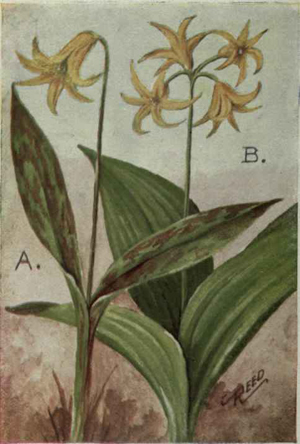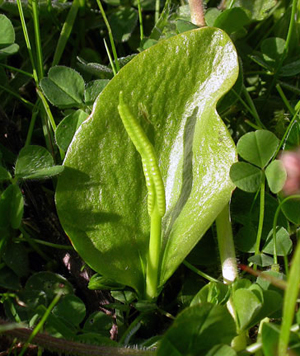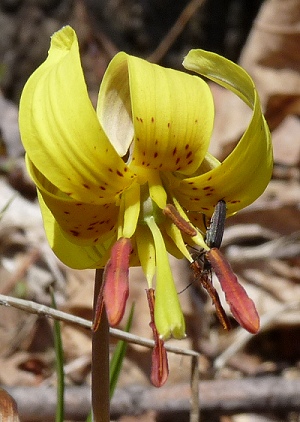Contents:
Common Names | Parts Usually Used | Plant(s) & Culture | Where Found | Medicinal Properties
Uses | Formulas or Dosages | Bibliography
Scientific Names
 |
- Erythronium americanus L.
- Erythronium americanum L.
- Liliaceae
- Lily family
Common Names
- Dog-tooth violet
- Erythronium
- Lamb’s tongue
- Rattlesnake violet
- Serpent’s tongue
- Snake leaf
- Trout lily
- Yellow erythronium
- Yellow snakeleaf
- Yellow snowdrop
Parts Usually Used
Bulb, leaves
Back to Top
Description of Plant(s) and Culture
 |
Adder’s tongue is a perennial plant to 1 foot high; its bulbous root is light brown on the outside and white inside. It grows two leathery, basal, lanceolate, pale green, mottled leaves with purplish or brownish spots; and one drooping, miniature, lily-like, yellow flower, petals strongly curved back, nodding from the top of a central stem, appears in April or May. The narrow spike somewhat resembling a snake’s tongue gave the plant the common name of adder’s tongue. The petals partially close at night and on cloudy days; the plant diminishes with the heat of summer. The fruit is a capsule.
Other varieties: E. californicum; E. giganteum or watsonii; E. hendersonii; E. dens-canis (dog tooth violet), White trout-lily (E. albidum) flowers are white, leaves seldom mottled; found in Ontario to Georgia; Kentucky, Arkansas, Oklahoma to Minnesota; E. grandiflorum is a plant that grows in western North America, been shown to be slightly antimutagenic.
Back to Top
Where Found
Grows in thin moist woods or open areas, moist meadows, with rich soil all over the United States. Nova Scotia to Georgia; Arkansas, Oklahoma to Minnesota.
Back to Top
Medicinal Properties
Emetic, expectorant, anti-scrofulous, antiscorbutic, emollient, antiscorbutic, nutritive when dry
Back to Top
Uses
Used for scrofula and other skin problems. Make a poultice for external application and take the infusion at the same time. Mix the expressed juice with cider for internal use if preferred, it probably tastes better. Poultice used for old or scrofulus ulcers, wounds, and tumors, draw out splinters, reduce swelling. Fresh root simmered in milk helps dropsy, hiccoughs, vomiting and bleeding from the lower bowels. Water extracts are active against gram-positive and gram-negative bacteria. Native Americans used the root tea for fevers. Iriquois women ate raw leaves to prevent conception.
Back to Top
Formulas or Dosages
 |
The plant must be used fresh.
Infusion: use 1 tsp. fresh leaves or
Poultice: use crushed leaves, or simmer the root in milk to get the proper consistency. Apply
Back to Top
Bibliography
![]() The Herb Book
The Herb Book, by John Lust, Bantam Books, 666 Fifth Avenue, New York, NY. copyright 1974.
![]() American Folk Medicine
American Folk Medicine, by Clarence Meyer, Meyerbooks, publisher, PO Box 427, Glenwood, Illinois 60425, 1973
![]() Eastern/Central Medicinal Plants
Eastern/Central Medicinal Plants, by Steven Foster and James A. Duke., Houghton Mifflin Company, 215 Park Avenue South, New York, NY 10000
![]() Culpeper’s Complete Herbal & English Physician: Updated With 117 Modern Herbs
Culpeper’s Complete Herbal & English Physician: Updated With 117 Modern Herbs, by Nicholas Culpeper, Meyerbooks, publisher, PO Box 427, Glenwood, Illinois 60425, 1990, (reprint of 1814)
![]() Indian Herbalogy of North America
Indian Herbalogy of North America, by Alma R. Hutchens, Shambala Publications, Inc., Horticultural Hall, 300 Massachusetts Avenue, Boston, Massachusetts 02115, 1973
![]() Webster’s New World Dictionary
Webster’s New World Dictionary, Third College Edition, Victoria Neufeldt, Editor in Chief, New World Dictionaries: A Division of Simon & Schuster, Inc., 15 Columbus Circle, New York, NY 10023
 The Rodale Herb Book: How to Use, Grow, and Buy Nature’s Miracle Plants (An Organic gardening and farming book)
The Rodale Herb Book: How to Use, Grow, and Buy Nature’s Miracle Plants (An Organic gardening and farming book), edited by William H. Hylton, Rodale Press, Inc. Emmaus, PA, 18049., 1974
